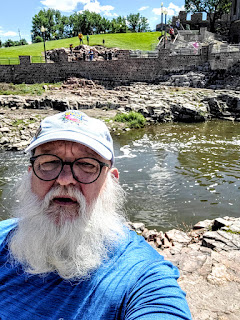Leaving Minnesota was delayed by a couple of hours...
Gee, what am I doing on the ground? the front rail of the slide decided to come off the gear that moves the slide in and out; this is the second time it has happened in three years. Fortunately for me, I paid attention to the tech the first time it did this.We made it to South Dakota on tailwinds all the way. Our first stop in South Dakota was Sioux Falls KOA.Carol and I went for a stroll one day. Across the street was a brewhouse for one of the local beers, so we went over, but the tasting room was closed (can't find help to operate it), but they did have another tasting room in downtown Sioux Falls. It just so happened that rattling the door caught the attention of someone in the building, and this someone happened to be one of the co-founders. He gave us a few samples to try, and while they were good, they didn't intrigued us enough to go downtown for more. From the brew house we walked up to Camping World, which is right next to the campground.
One day we took a drive into town to see the namesake of the town, Sioux Falls.This photo was taken from the observation tower in park. The Big Sioux River is down today, partially due to drought, and possibly dams built upstream.Unfortunately progress managed to corrupt the landscape...This is the lower falls in the early 1900s, but quarrying companies started mining the Sioux Quartzite rocks and boulders for buildings. In 1912 the remaining rock was removed to improve water flow for the hydroelectric plant.This is what is left of the lower falls today, nada.
What were some of the other changes that altered the course of the Big Sioux River? One of the changes was the creation of the Queen Bee Mill.The falls were the heart of Sioux Falls, known as Queen City, and the mill was the center of activity in the 1880s. The mill commanded attention with its seven-story building, and innovative machinery.
The seven-story building housed milling machinery, a 100,000 bushel grain elevator, could warehouse 10,000 barrels, there was a turbine house, a gate house, and a cooper shop (barrel maker). It was equipped to produce 1,200 barrels of flour a day, which was about four times the amount produced by the Midwest mills.
MILL IN CIRCA 1881
QUEEN BEE MILL COMPLEX CIRCA 1881
TURBINE HOUSE
GATE HOUSE
On the left side of the lower gate house photo is a portion of the redirected Big Sioux River, which became the mill pond. The pond water flowed through the gate house to the turbine house, and drove the mill machinery. The saddles in the upper photo supported the piping from the gate house to turbine house.
HYDROELECTRIC PLANT
In the early 1900s the hydroelectric plant was built. As you might notice in the photo above, the water line for the river was much higher years ago.If you remember, I mentioned that the river course was changed to accommodate (destruction of the lower falls) the hydroelectric plant. The water flowed through the bottom channels of the plant. The hydroelectric plant is now a café.Several groups of explorers, including Lewis & Clark passed this way, providing their views, in reports, to folks in the east. In 1856 speculators scarfed up the land around the falls, figuring that settlers would come in droves, and want to buy land from the speculators.
Their optimism was thwarted with the fear of the Civil War, fear of confrontation with the native tribes, a depression, and the slowed down construction of the railroad. In 1862 the township was abandoned because of conflict with the native tribes (Dakota War of 1862) and settlers in nearby southern Minnesota.
15 years later a new group of speculators arrived and invested in the area, building the mill, quarries, and other industries. Once the railroad arrived in 1878, the city flourished. The railroad tracks are still in use today...
The Sioux Quartzite stone around the falls was used in construction of buildings, and roads. In the beginning the stone was highly prized. Once new construction technology arrived, the quartzite stone lost favor, due to the high cutting costs.
Here is something none of you have ever experienced...
MATT "ON THE ROCKS"
* Matt "on the Rocks" is not sold in any stores or bars.
Now, what growing territory can go without a penitentiary, Dakota Territory was no different. In 1881, Congress appropriated $30,000 for the construction of a prison large enough to hold 150 inmates. In 1882 financing came in the form bonds for the amount of $30,000. The prison was built using quarried stone from the falls. In November of 1882 the first wing of the prison was completed, and the prisoners sent to Detroit, Michigan, were returned to finish their sentences.
There is an interest in re-building Sioux Fall, and part of that is through art.
The "ODE" in the bottom photo is of the restaurant we stopped at for lunch. The full name of the restaurant is Ode to Food, and they make good food. We finished lunch and left out the front door of the building that the restaurant is in, and this sculpture was waiting for us on the way to the truck...
With our stay in Sioux Falls coming to an end, we now prepare for the next stop in Summit, SD.





















No comments:
Post a Comment